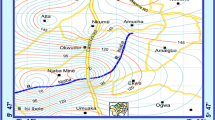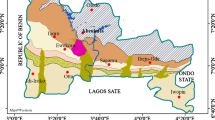Abstract
The proper design and successful construction of engineered structures require determination of the engineering properties of the soil. These properties, however, are conventionally determined in the laboratory using soil samples collected from the construction site. The collection of soil samples is generally an expensive and time-consuming activity, while the extraction of an undisturbed soil sample is difficult. Furthermore, there are wide variations in the temporal and spatial properties of soil and their accurate evaluation requires high-density sampling. Recently, electric resistivity surveying has attracted much attention. It is commonly applied in the analysis of engineering sites, as it is rapid, cost-effective, and non-destructive. Based on this hypothesis, electrical resistivity was measured at four boreholes in the areas surrounding the University of Peshawar using standard methods of resistivity survey, i.e., Schlumberger electrode configuration. The resistivity data that was obtained by vertical electrical sounding (VES) from the fieldwork was correlated with geotechnical data obtained through the analysis of soil samples in the laboratory. Electrical resistivity had an inverse relationship with gravimetric moisture content and cohesion, with the highest regression coefficients observed in the case of GYM-UAP and Girls’ Hostel-UAP (R2 = 0.97 and 0.96) boreholes, respectively. Moreover, electrical resistivity had a significant linear correlation with the angle of internal friction and standard penetration test-N (SPT-N) values, with the highest regression coefficient of GYM-UAP (R2 = 0.99) and Girls’ Hostel-UAP (R2 = 0.95), respectively. In conclusion, the obtained relationships between electrical resistivity and different geotechnical properties could be adopted for the assessment of geotechnical properties of soils, especially when many samples are difficult to obtain.




Similar content being viewed by others
References
Akintorinwa OJ, Oluwole ST (2018) Empirical relationship between electrical resistivity and geotechnical parameters: a case study of Federal University of Technology campus, Akure SW, Nigeria. NRIAG J Astron Geophys 7:123–133
Aleke CG, Ibuot JC, Obiora DN (2018) Application of electrical resistivity method in estimating geohydraulic properties of a sandy hydrolithofacies: a case study of Ajali Sandstone in Ninth Mile, Enugu State, Nigeria. Arab J Geosci 11:322. https://doi.org/10.1007/s12517-018-3638-8
Alsharari B, Olenko A, Abuel-Naga H (2020) Modeling of electrical resistivity of soil based on geotechnical properties. Expert Syst Appl 141:112966
ASTM D1586/D1586M-18 (2018) Standard test method for standard penetration test (SPT) and split-barrel sampling of soils. ASTM International, West Conshohocken
ASTM D2216-19 (2019) Standard test methods for laboratory determination of water (moisture) content of soil and rock by mass. ASTM International, West Conshohocken
ASTM D2487-17 (2017) Standard practice for classification of soils for engineering purposes (Unified Soil Classification System). ASTM International, West Conshohocken
ASTM D3080/D3080M-11 (2011) Standard test method for direct shear test of soils under consolidated drained conditions. ASTM International, West Conshohocken
ASTM D6913/D6913M-17 (2017) Standard test methods for particle-size distribution (gradation) of soils using sieve analysis. ASTM International, West Conshohocken
ASTM D7263-09(2018)e2 (2018) Standard test methods for laboratory determination of density (unit weight) of soil specimens. ASTM International, West Conshohocken
ASTM D854-14 (2014) Standard test methods for specific gravity of soil solids by water pycnometer. ASTM International, West Conshohocken
Atakpo EA, Ayolabi EA (2009) Evaluation of aquifer vulnerability and the protective capacity in some oil producing communities of western Niger Delta. Environmentalist 29(3):310–317
Braga A, Malagutti W, Dourado J, Chang H (1999) Correlation of electrical resistivity and induced polarization data with geotechnical survey standard penetration test measurements. J Environ Eng Geophys 4:123–130
Burbank DW, Tahirkheli RAK (1985) The magnetostratigraphy fission-track dating and stratigraphic evolution of the Peshawar basin, northern Pakistan. Geol Soc Am Bull 96:539–552
Cosenza P, Marmet E, Rejiba F, Cui YJ, Tabbagh A, Charlery Y (2006) Correlation between geotechnical and electrical data, A case study in Garchy in France. J Appl Geophys 60:165–178
Das BM (2007) Principles of geotechnical engineering. Thomson Learning: India. pp 323
Faisal N, Sadiq N (2009) Climatic zonation of Pakistan through precipitation effectiveness index. Pak J Meteorol 6(16):51–60
Farid A, Jadoon K, Akhter G, Iqbal MA (2013) Hydrostratigraphy and hydrogeology of the western part of Maira area, Khyber Pakhtunkhwa, Pakistan: a case study by using electrical resistivity. Environ Monit Assess 185(3):2407–2422
Giao PH, Chung SG, Kim DY, Tanaka H (2003) Electric imaging and laboratory resistivity testing for geotechnical investigation of Pusan Clay deposits. J Appl Geophys 52:157–175
Hasan M, Shang Y, Akhter G, ** W (2018) Evaluation of groundwater potential in Kabirwala area, Pakistan: a case study by using geophysical, geochemical and pump data. Geophys Prospect 66:1737–1750
Hatta KA, Osman SBAS (2015) Correlation of electrical resistivity and SPT-N value from standard penetration test (SPT) of Sandy Soil. Appl Mech Mater 785:702–706
Hen-Jones RM, Hughes PN, Stirling RA, Glendinning S, Chambers JE, Gunn DA, Cui YJ (2017) Seasonal effects on geophysical–geotechnical relationships and their implications for electrical resistivity tomography monitoring of slopes. Acta Geotech 12:1159–1173
Herman R (2001) An introduction to electrical resistivity in geophysics. Am J Phys 69(9):943–952
Jiang L, Zhao Y, Golsanami N, Chen L, Yan W (2020) A novel type of neural networks for feature engineering of geological data: case studies of coal and gas hydrate-bearing sediments. Geosci Front 11:1511–1531. https://doi.org/10.1016/j.gsf.2020.04.016
Kearey P, Brooks M, Hill I (2002) An introduction to geophysical exploration. Blackwell Science
Liu SY, Du YJ, Han LH, Gu MF (2008) Experimental study on the electrical resistivity of soil-cement admixtures. Environ Geol 54(6):1227–1233
Mehmood Z, Khan NM, Sadiq S, Mandokhail S-UJ, Ashiq SZ (2020) Assessment of subsurface lithology, groundwater depth, and quality of UET Lahore, Pakistan, using electrical resistivity method. Arab J Geosci 13:281. https://doi.org/10.1007/s12517-020-5260-9
Naseem A, Jalal F, Naseem A (2020) Predicting sandy-clayey soil properties using electrical resistivity testing. Proc Inst Civ Eng Geotech Eng 173(1):21–29
Oh S, Sun CG (2008) Combined analysis of electrical resistivity and geotechnical SPT blow counts for the safety assessment of fill dam. Environ Geol 54(1):31–42
Olayinka LA, Lawal KM, Ahmed AL, Aremu BG, Abubakar F, Usman A, Daniel E (2019) Correlation of geoelectrical and geotechnical parameters of data obtained from geophysical survey conducted at Ahmadu Bello University Phase II, Zaria, Nigeria. Appl J Physic Sci 1(2):14–23
Olorunfemi MO, Akintorinwa OJ, Iginla IB, Bayowa GO (2010) Micro-resistivity measurements, near-surface sequence delineation, and empirical relationships with engineering geotechnical parameters. Pac J Sci Technol 11(1):537–544
Osman SBS, Fikri MN, Siddiqui FI (2014) Correlation of electrical resistivity with some parameters for development of possible prediction of slope stability and bearing capacity of soil using electrical parameters. Pertanika J Sci Technol 22(1):139–152
Ozcep F, Tezel O, Asci M (2009) Correlation between electrical resistivity and soil water content. Istanbul Golcuk. Int J Physic Sci 4(6):362–367
Ozcep F, Tezel O, Asci M, Karabulut S (2010) Correlation between electrical resistivity and soil-water content based artificial intelligence techniques. Int J Physic Sci 5(1):47–56
Pozdnyakov AI, Pozdnyakova LA, Karpachevskii LO (2006) Relationship between water tension and electrical resistivity in soils. Eurasian Soil Sci 39:S78–S83
Qiang Z, Yasin Q, Golsanami N, Du Q (2020) Prediction of reservoir quality from log-core and seismic inversion analysis with an artificial neural network: a case study from the Sawan gas field, Pakistan. Energies 13:486. https://doi.org/10.3390/en13020486
Rafiq M, Jan MQ (1989) Geochemistry and petrogenesis of the Ambela granite complex, NW Pakistan. Geol Bull Uni Peshawar 22:159–179
Rao GT, Rao VVSG, Padalu G, Dhakate R, Sarma VS (2014) Application of electrical resistivity tomography methods for delineation of groundwater contamination and potential zones. Arab J Geosci 7:1373–1384. https://doi.org/10.1007/s12517-013-0835-3
Rasul H, Zoul L, Olofsson B (2018) Monitoring of moisture and salinity content in an operational road structure by electrical resistivity tomography. Near Surf Geophys 16:423–444
Reynolds JM (1997) An introduction to applied and environmental geophysics. Wiley, New York
Reynolds JM, Paren JG (1980) Recrystallization and the electrical behaviour of glacier ice. Nature 283(5742):289–295
Reynolds JM, Paren JG (1984) Electrical resistivity of ice from the Antarctic Peninsula. J Glaciol 30(106):289–295
Robain H, Camerlynck C, Bellier G, Tabbagh A (2003) Laboratory measurements of electrical resistivity versus water content on small soil cores. Geophys Res Abstr 5:03830
Roodposhti HR, Hafizi MK, Kermani MRS, Nik MRG (2019) Electrical resistivity method for water content and compaction evaluation, a laboratory test on construction material. J Appl Geophys 168:49–58
Sadek M (1993) A comparative study of electrical and hydraulic conductivities of compacted clay. PhD Thesis. Dept. of Civil Engineering, University of California at Berkeley, Berkeley
Samouёlian A, Cousine I, Tabbagh A, Braund A, Richard G (2005) Electric resistivity survey in soil science: a review. Soil Tillage Res 83:173–193
Schwartz BF, Schreiber ME, Yan T (2008) Quantifying field-scale soil moisture using electrical resistivity imaging. J Hydrol 362(3-4):234–246
Shah MT, Ali L, Khattak SA (2007) Gold anomaly in the quaternary sediments of Peshawar basin, Shaidu area, district Nowshera, NWFP, Pakistan. J Chem Soc Pak 29(2):116–120
Shevnin V, Mousatov A, Ryjov A, Delgado-Rodriquez O (2007) Estimation of clay content in soil based on resistivity modelling and laboratory measurements. Geophys Prospect 55:265–275
Siddiqui FI, Osman SBABS (2012) Integrating geo-electrical and geotechnical data for soil characterization. Int J Appl Phys Math 2(2):104–106
Siddiqui FI, Osman SBABS (2013) Simple and multiple regression models for relationship between electrical resistivity and various soil properties for soil characterization. Environ Earth Sci 70(1):259–267
Spoor G, Godwin RJ (1979) Soil deformation and shear strength characteristics of some clay soils at different moisture contents. J Soil Sci 30(3):483–498. https://doi.org/10.1111/j.1365-2389.1979.tb01003.x
Stauffer KW (1968) Geology of the Khyber Pass, Khyber Agency West Pakistan. US Geol Surv Project Rep (IR) PK 22:42
Sudha K, Israil M, Mittal S, Rai J (2009) Soil characterization using electrical resistivity tomography and geotechnical investigations. J Appl Phys Math 67:74–79
Sultan SA, Mekhemer HM, Santos FAM, AbdAlla M (2009) Geophysical measurements for subsurface map** and groundwater exploration at the central part of the Sinai Peninsula, Egypt. Arab J Sci Eng 34(1A):103–119
Syed BA, Siddiqui FI (2012) Use of vertical electrical sounding (VES) method as an alternative to standard penetration test (SPT). Proceedings of 22nd International Offshore and Polar Engineering conference Rhodes, Greece
Ullah K, Arif M, Shah MT, Abbasi IA (2009) The lower and middle Siwaliks fluvial depositional system of western Himalayan foreland basin, Kohat Pakistan. J Himal Earth Sci 42:61–85
Yan W, Sun J, Zhang J, Golsanami N, Hao S (2017) A novel method for estimation of remaining oil saturations in water-flooded layers. Interpretation 5:SB9–SB23. https://doi.org/10.1190/INT-2016-0074.1
Zananiri I, Memou T, Lachanas G (2006) Vertical electrical sounding (VES) survey at the central part of Kos Island, Aegean, Greece. In: Yanev Y, Sachanski V, Jelev V, Koleva-Rekalova E, Botev E, Cherneva Z, Damyanov Z, Dobrev N, Tarassov M, Shanov S, Tarassova E, Tzvetanova Y, Velinova N (eds). Proceedings of the national conference on “Geosciences 2006”. Bulgarian Geological Society, Sofia Bulgaria, pp 411–413
Funding
Financial support and research facilities were provided by the National Centre of Excellence in Geology, University of Peshawar, 25120, Peshawar, Pakistan.
Author information
Authors and Affiliations
Corresponding author
Ethics declarations
Competing interests
The authors declare that they have no competing interests.
Additional information
Responsible Editor: Zeynal Abiddin Erguler
Electronic supplementary material
ESM 1
(DOCX 1986 kb)
Rights and permissions
About this article
Cite this article
Islam, I., Ahmed, W., Rashid, M.U. et al. Geophysical and geotechnical characterization of shallow subsurface soil: a case study of University of Peshawar and surrounding areas. Arab J Geosci 13, 949 (2020). https://doi.org/10.1007/s12517-020-05947-x
Received:
Accepted:
Published:
DOI: https://doi.org/10.1007/s12517-020-05947-x




